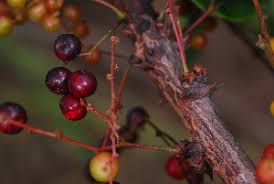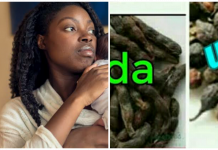Phyllanthus muellerianus (Kuntze) Exell (synonyms: Phyllanthus floribundus (Baill.) Müll. Arg., Diasperus muellerianus Kuntze Revis.) or Kumci or Májírìyár kúrumiì (Hausa) or Anya nnụ̀nụ̀ = bird’s eye (Igbo) or Arunjeran (Yoruba): A multipurpose African shrub
Phyllanthus muellerianus occurs from Senegal and Guinea Bissau east to Sudan and Kenya and south to northern Angola and northern Mozambique.
HEALTH BENEFITS/IMPORTANCE OF PHYLLANTHUS MUELLERIANUS
Phyllanthus muellerianus is widely used to treat intestinal troubles. Leaves are an occasional supplement cooked with food or in soup in Sierra Leone and Southern Nigeria. In Ghana and in Nigeria, leaves boiled with the palm fruit are given as soup to women after delivery. The fruits are edible and are eaten by some people.
The dry fruit contains per 100 g: 77 g water, 9.7 g protein, 4.3 g fat, 500 mg Ca, 200 mg P and 15 mg Fe. It has an energetic value of 294 kcal. In Ivory Coast, the leaves are eaten in the belief that they promote male fertility. An infusion of the young shoots is taken to treat severe dysentery. In Sierra Leone a leaf decoction is taken to treat constipation.
In Ghana and Nigeria cooked roots, sometimes with maize meal or other plants, are taken to treat severe dysentery. In Congo, powdered roasted roots with palm oil are taken to treat stomach problems and as an anti-emetic. In Tanzania, roots are pounded in water and the liquid is drunk to treat diarrhoea. Boiled roots are also applied as enema to treat stomach-ache. A clear potable water may be obtained from the cut stem and this sap is used in Sierra Leone to relieve ophthalmia, and in Nigeria for pain in the eyes, or to remove a foreign body.
In Côte d’Ivoire and Burkina Faso, twigs are sucked to lessen toothache and in Nigeria, twigs are used as chew-sticks after removal of the surface spines. Powdered roots are used as a snuff and a bark decoction is taken to treat a sore throat, cough, pneumonia and enlarged glands. Pulped leafy twigs are rubbed on the body to treat paralysis.
In Nigeria, a root bark decoction is taken as an alterative and to treat fever. A twig and root decoction is taken to treat jaundice and urethral discharges. In the Central African Republic fresh root bark is crushed and macerated in water or palm wine, and the liquid drunk as an aphrodisiac. In Gabon, roasted powdered twigs are eaten with plant ash to treat dysmenorrhoea.
In Democratic Republic of Congo, dried bark powder is sniffed to treat colds and sinusitis. For cough, the root in Ghana is cut into small pieces with those of Psychotria calva and Harrisonia abyssinica and decocted and the liquid drunk. This prescription is also given for whooping-cough. A root bark decoction is applied to swellings and is drunk to treat gonorrhoea. Stem ash is applied to scarifications to treat rheumatism and intercostal pain. In Tanzania, a root decoction is taken to treat hard abscesses; powdered dried roots and stem bark are sprinkled on wounds as a dressing.
In Nigeria, a root-decoction is used as a febrifuge and an infusion of roots and leaves is given to children in Togo suffering from eruptive fevers. A decoction is taken in draught and made into a vapour-bath on the exposed genitals as a pelvic decongestant, and by draught for anaemia in Ivory Coast. The powdered roots are used in Ivory Coast as a snuff together with a bark-decoction in draught and enema for throat-troubles with glandular fevers. In Nigeria, the young root, with young leafy twigs, is given for jaundice and as a mild purgative and to treat dysentery and urethral discharges.
Throughout West Africa, pounded leaves are applied as wound dressing. In Côte d’Ivoire, the leaves are eaten, together with young leaves of Funtumia elastica (Preuss) Stapf, to improve male fertility. In Ghana and Nigeria, leaves boiled with palm fruit are given to women after delivery as a general tonic. In Cameroon a maceration of the leaves and roots is used to wash the body to treat rash with fever in children.
In Democratic Republic of Congo, a leaf decoction is taken to treat anaemia and also used as a mouthwash to treat toothache. A leaf extract is used as a bath and a vapour bath to treat venereal diseases. Cooked leaves are applied to the gums to treat toothache. A flower infusion is cooling and gently aperient. The fruits are edible and slightly acidic. In Sierra Leone and Nigeria, the sap from the hollow branches is considered potable. In Cameroon, the bark is sometimes added to palm wine to render it strongly intoxicating.
In Kenya, the stems are considered excellent firewood; branches thicker than 15 cm become hollow and are less used. In East Africa the, brown dye from the bark is used to dye mats and fishing lines. From the whole plant a black dye is obtained used to colour fibres. In Zambia, the wood is used for rafters and other construction work. It is also used to make fish traps and basketry. The leaves are used as fodder. In Sierra Leone and Nigeria, leaves are sometimes cooked with food or in soup as a seasoning. Fruit pulp is used as a hair fixative. The plant has superstitious attributes. In Sierra Leone, it is held to be taboo to the Ture clan of the Temne. In parts of Sierra Leone, the leaves, mixed with cow-dung, are rubbed on the floor of huts.

In Gabon, it is believed to have the power to lift taboos and ritual interdictions. Analyses of the plant have shown no alkaloids, but only the presence of non-toxic tannins.
FUTURE: Phyllanthus muellerianus has many local medicinal uses, especially to treat intestinal problems, against body pain and as an antiseptic. Preliminary pharmacological analyses confirm these uses, although virtually nothing is known concerning the compounds responsible for these activities. More research is therefore warranted.
SOURCES: Grassland and pasture crops. Country pasture/forage resource profiles. [Internet] Ministry of Food & Agriculture, Accra, Ghana; Traditional herbal drugs of southern Uganda, 2: literature analysis and antimicrobial assays. Journal of Ethnopharmacology 84: 57-78; International Journal of Biology Chemistry Sciences 3(5): 1021-1029; 2009.
These are the thoughts of:
Sa’eed Halilu Bawa
Senior Lecturer (Associate Professor) at University of the West Indies, St. Augustine Campus, Trinidad.
Studied Food and Nutrition Sciences, Dietetics at Kaduna Polytechnic, Nigeria; Warsaw University of Life Sciences, Poland.
























